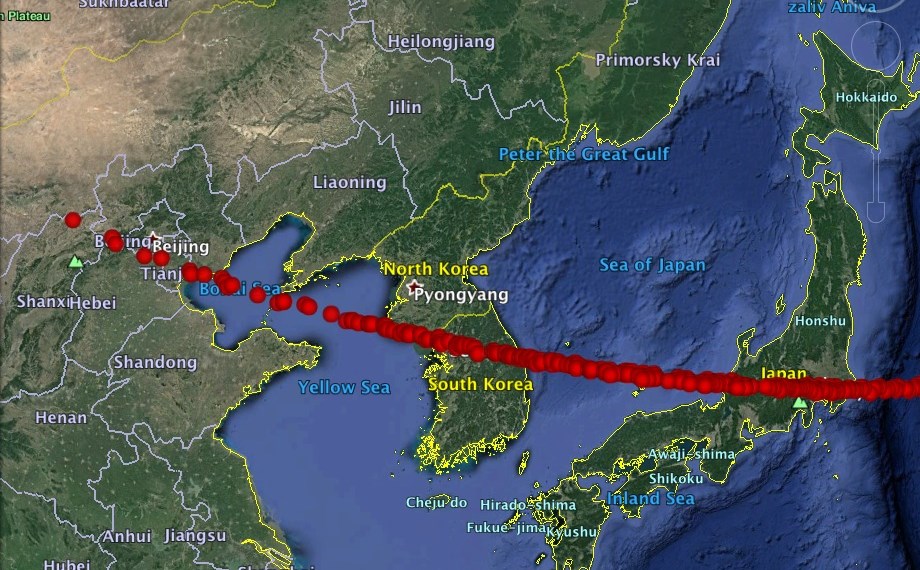・Press Release
・Press Briefing Charts
・Impact Effects Briefing
・The taxonomy of this object (therefore approximate density) is likely known assuming that routine monitoring programs will have already yielded a spectral classification and a good lightcurve
・Hubble Space Telescope and 8-10 m class facilities on the ground should be used next year, when the object will reach magnitude 27, to get additional astrometric follow-up
・Plan to use JWST, which should be available by the end of 2018, for astrometric observations
・Check WISE data to see if the object has been seen during the current apparition, when it crossed 90° elongation, to possibly estimate the diameter and albedo (which may also solve any ambiguities of spectral class)
・Explore the possibility that ground based NIR facilities may see thermal signatures slightly above 2 microns, which would allow for a determination of the diameter
・Explore whether Gaia may be capable of providing high-precision astrometry on this object at V~20.5 (peak for the current apparition). This is too faint for the routine mode of operation of Gaia, but it may be within reach if the spacecraft is used to its limiting magnitude.
・Land impacts are more severe than impacts over water (tsunamis present a lower risk)
・Each impactor will move the risk corridor 460km east: 2-3 hits could move the entire risk corridor into the Pacific Ocean
・The mean blast radius is likely to be 50-150 km, with a worst case of 250km, so the impact point needs to be at least this far offshore
・Size characterization is less important now that the corridor has been narrowed down ? the specifics of how to act are now less sensitive to size
・Tightening up the uncertainty in the impact ellipse will help
・Given COST and RELIABILITY consideration, two deflection mission options are proposed
・The first option includes two “active” rendezvous ships carrying nuclear devices to launch in June, 2020 at a cost of $3 billion
・The second option includes two “passive” rendezvous missions with no nuclear devices, but with 6 kinetic impactors. Rendezvous missions to launch in June 2020 at a cost of $8 billion ($2 billion for the rendezvous spacecraft + $6 billion for the kinetic impactors)
・For the second option, start with an East-ward deflection plan. Attempt to make March 2020 launch date. The impactors arrive before the rendezvous mission. A total of 6 interceptors provides redundancy because we calculate, based on current estimates of the asteroid properties, that 3 impactors are required to deflect the asteroid. The East-ward deflection plan uses solar electric propulsion (SEP).
・If the East-ward launch date is not possible, continue spacecraft construction efforts and go for a West-ward deflection launch date, which is in July, 2023. The West-ward deflection will benefit from 7 weeks of data from the rendezvous ship(s). The West-ward deflection plan uses chemical propulsion.
・Consider 50% failure per mission because of the non-standard circumstances and high stakes
・Eastward deflection is recommended
・A precision drop on central Asia (westward deflection) is very difficult
・Nuclear devices on rendezvous missions are recommended
・A nuclear deflection will require only 1 successful mission, but a kinetic impactor deflection will require 3 successful missions
・Six eastward deflection missions are recommended for launch
・Nuclear warheads are recommended for launching on the rendezvous missions
・Keep all deflection options open (eastward, westward, nuclear)
・Formation of formal decision-making body is recommended since political coordination at the highest level is required given the complex nature of this problem (4 countries in risk corridor, other countries with space agencies will launch missions)
・Clear, concise, and consistent information must be publicly available
・Prepare to answer the big questions from the public, including details about the Kinetic Impactor missions. The justification of the east versus west deflection and the decision process for building and launching will need to be made clear.
・Communication will occur through established processes with the UN to understand, monitor, and plan. Publicly recognisable organisations such as the Red Cross could be asked to lend their support in disseminating information.
・Instill hope for the future: The nations are working together, we have the technology to solve this problem, and we are doing everything we can to prevent this disaster and to preserve lives and livelihoods.
・Be ready for challenging questions: How do we know that decision makers are right? Are we using nuclear weapons? Who is going to pay for all of these missions? What if the missions are not successful? What is the Plan B?
・2024 is the key date
・The goal is to plan so that nobody dies from the impact
・Mitigate economic issues, insurance
・International agreements between countries in impact zone within 6 months
・Incentivize other countries to participate due to uncertainty and refugees within 6 months
・The tsunami threat needs to be considered
・Slogan: “No fatalities” “Nobody dies”
・All Possible Earth/Space based observations are funded
・Number of Flyby Spacecraft ? 2 as recommended by scientists (investigate AIDA-like inclusion)
・Number of Rendezvous Spacecraft ? 2 for June 2020 (no nuclear device)
・Number of Impactor Spacecraft ? 8 of multiple designs
・Impactor missions will be for eastward deflection (westward if failure to meet launch window)
・No action taken yet to address economic issues
・The possibility for a unilateral launch of a hypervelocity nuclear mission remains open

The latest impact footprint released by the International Asteroid Warning Network (IAWN), indicated by the red dots on this image. There is a 96% chance that 2017 PDC will impact somewhere within this long narrow region stretching from eastern China through North and South Korea, across Japan, and into the Pacific Ocean.
Background information on the scenario.
To study this scenario using the JPL HORIZONS system, click here.
Description of NASA/JPL NEO Deflection App.
Using the Deflection App for the PDC 2015 scenario.